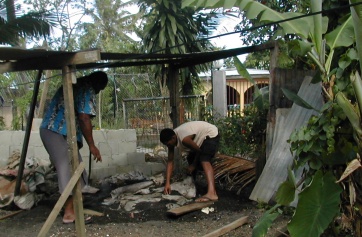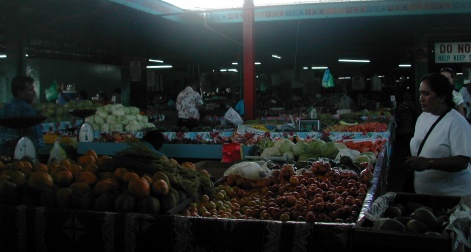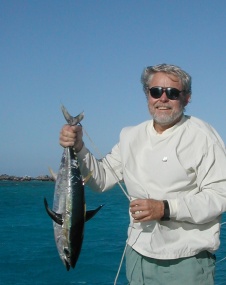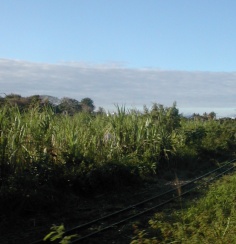VITI LEVU
Viti Levu means ‘great Fiji’. It is great in both size and importance.
Viti Levu is approximately oval shaped and measures 91 miles in a north-south direction and 66 miles in an east-west direction. The total land area of the island is just over 4,000 square miles. The only larger Pacific islands are New Caledonia and Hawaii.
Viti Levu is a volcanic island with a ridge running nearly north-south. As the southeast tradewinds cross the island, the windward slopes to the east experience heavy rainfall, and the leeward land to the west is markedly drier.
Viti Levu supports Fiji’s most dense population centers – Suva and Nadi – and its two largest cities – Suva and Lautoka. Viti Levu also has extensive sugar plantations, some gold mines, numerous dairy farms, and some light manufacturing. However, most importantly, it is the center of Fiji’s number one source of income – tourism.
Fiji’s international airport is at Nadi – on the west end of the island. However, its largest city – Suva – is near the southeast corner of the island. We entered Fiji at Suva Harbor, and our travels within Fiji began there. We returned to Viti Levu at Lautoka. These are both interesting cities worth visiting.
We arrived in Suva after an eight-day passage, and we were instructed to anchor near the Royal Suva Yacht Club to complete check-in formalities. By the time we ate and launched our dinghy it was late in the day, and we were able to postpone our check in till the following morning.
In the morning, Nita stayed on-board to continue putting the boat back together while Bud went ashore to check us in. Most of the check in process went smoothly; however, the immigration office remained closed through much of the afternoon (or so Bud thought – he was at the wrong office). Bud roamed the dock waiting for the office to reopen, and this is how he met our friend, Joe.

Uncovering the lovo
Joe has worked for Suva Port Control for 18 years – 12 years in the tower and six years on the dock. He noticed Bud wandering about and struck up a conversation with him. They became instant friends.
Joe is originally from the island of Totoya which is one of the western-most islands of the Lau group. He explained that the chief of his village there had recently died, and the island was observing a 100-day mourning period. That mourning period ends on June 26, and a new chief will take over. The spokesperson for the new chief is Joe’s cousin.
Joe asked if we would be interested in visiting Totoya and attending the ceremonies surrounding the new chief. We were definitely interested, but we also knew that the Lau group stopped issuing cruising permits in 1992, so we did not expect to get permission to visit. But Joe and Bud were persistent, and after about ten days, we did get a permit as did our friends, Glen & Renee, on SV Learjet.
Joe also invited us to his home to meet his family and enjoy a Fijian lovo (underground oven) meal. He has a warm and welcoming extended family, and they prepared quite a feast for us. After a huge meal, Joe and his wife, Asenaca, came out to the boat for a quiet visit. They commented that their children would enjoy visiting the boat, so we invited them back the following day.
We spent a busy day on board with Joe, Asenaca, their two children – eight-year-old Queenie and 12-year-old Tavita – and their cousin Taka. The kids swam, we sailed our radio controlled sailboat, and Bud taught everyone how to drive the dingy. A good time was had by all.
While Bud spent much of his time with Joe, Nita got out and explored the city. Suva, the largest city in Fiji, is a noisy and busy place with lots to see and do. We saw the usual tourist attractions (President’s residence, museum, etc.) and a few probably not on most tourist itineraries. Across the street from the yacht club was Suva Prison, and it was a dreadful looking place. We were surprised to hear that prisoners are housed there, and we were even more surprised to learn that it is only a medium security prison. But a block up the street is the brewery, and the smell of cooking wort took our minds to a better place. And as always, we really enjoyed getting out among the locals.

Inside the marketplace
Suva’s greatest attraction to most cruising sailors is its market. It has a huge mostly-indoor market where one can buy any produce currently available, and the prices are surprisingly inexpensive (as was most of what we found in Suva). The ground floor is produce, and the upper floor is spices and yaqona (Fiji’s version of kava).
Fiji’s largest Indian population is in Suva. Their influence is throughout the city, and we were thrilled to find so much Indian food from which to choose. We ate at three different curry houses (meal prices ranging from $2.90 to $4.80 F), and each was good.
We found most things we wanted to buy, and internet access was readily available in town. There was even a multiplex theater, but we didn’t make it to a movie.
However, we had had enough ‘city time’ in New Zealand, and we were anxious to get out to the islands. According to our Fiji cruising guide, there is a lovely anchorage – Nukulau Island – just seven miles out of Suva, so we headed there for an overnight stop before heading south to Kadavu to visit our friends from Honolulu, Joe and Connie, whom have been living there for a few years.
When we weighed our anchor in Suva harbor, we brought up the worst looking muck we have found anywhere. It was black mud that looked like tar, and it was firmly stuck to our chain and anchor. Again, our saltwater pump saved the day. But we were not discouraged. We were finally getting back to the part of cruising that we enjoy.
The short trip to Nukulau Island can be done inside of the reef or outside. We chose to travel inside the reef. Navigating through the coral required our full-time attention, but it was not particularly difficult. We were at Nukulau Island within a few hours. That would also be Nukulau Prison. Nukulau Island has been converted to a prison that houses George Speight and his boys that attempted a governmental coup a few years ago.
So we quickly prepared Passage for the trip across Kadavu Passage, and we were off. We said goodbye to Suva a bit quicker than planned, but we were excited to be heading for Kadavu.
Follow us to Kadavu Island or read below about our time in and around Lautoka.

Yellowfin tuna
The island of Vatulele is approximately mid-way between Kadavu and Lautoka. So we planned to make this a two day trip with an overnight stop at Vatulele.
Our trip from Kadavu to Vatulele was relatively uneventful even if a but bumpy. However, our arrival there was a bit more exciting. We cleared the narrow and shallow pass without incident, but we found another minefield of bommies ahead of us. The wind had been blowing around 30 knots for a few hours, so we did not want to leave and sail on to Lautoka. We were determined to make our way to the lee of a small guano-covered rocky island that we affectionately called Bird Shit Island. Although we were often in as little as 11 feet of water (we draw 6.5′) with bommies reaching the surface, we made it in and anchored in 15′ sand.
We had gotten so busy negotiating the bommies that we left our fishing gear out until we were in the lee of Bird Shit Island. We brought it in to find a nice yellowfin tuna on our lure. This fish had been hit by a shark while on our lure, and he was a bit thrashed (tooth marks, parts of fins missing), but the shark did not get him. He was delicious.
Although the winds were only 18 knots in the lee of the island when we anchored, they increased to the mid-to-high twenties. We did not want to try to thread our way out through the minefields in winds greater than that, so we stayed for two nights until we got a brief break in the wind. We took a different course out of the lagoon, and there were fewer bommies; however, at times we had only 8′ of water under us. Ah, sailing is such a relaxing way to travel…
We had a great sail from Vatulele to Lautoka. Actually, we anchored in Momi Bay which is about 20 miles south of Lautoka, and we had a wonderfully calm and secure anchorage to ourselves. And the following morning, we went in to Vuda Point Marina – just south of Lautoka.
Vuda Point has a fuel dock, propane nearby, and bus service to Lautoka. We went to Lautoka the following morning, and we were pleasantly surprised by the quantity and selection of food we found. This would be a good place to stop for a few days until we were ready to head northwest to the Yasawas.
Lautoka calls itself ‘Sugar City’, and they do have a busy sugar mill. Sugar cane grows all around the area. There is even a small-gauge railway called the ‘cane train’ that carries sugar to the mill; however, the vast majority of cane is transported by large flat-bed trucks. The mill runs day and night, and there are seemingly constant fires burning the cane fields. The smoke and ash were sometimes overwhelming.

Sugar cane fields & cane train track
The weather was deteriorating when we returned from our first trip to Lautoka, and it stayed lousy for about ten days. Nita’s brother, Tom, was scheduled to arrive for a visit on August 19, so we decided to just hang out till he joined us. There we stayed.
Tom arrived as scheduled on August 19, but it was still a bit too blustery to leave. But we did get out and head for the Yasawas on August 20. During his visit, we went to the Yasawa Islands and the northernmost Mamanuca Islands.
Tom had to fly back to the US on September 3, so we headed back to Vuda Point on September 2, and we caught a nice little walu along the way. We stayed at Vuda Marina for a few days to rest up, then we stayed another few days to see our friends Don and Gwen on Tackless II whom were passing through for the afternoon on September 6. We had another few days of lousy weather, but we again got out on September 9.
We planned to sail west-northwest to return to the northernmost Mamanuca island of Navadra that we had so thoroughly enjoyed a week earlier, but the winds were contrary. So we fell off and had a beautiful sail to the more southerly Mamanucas. After a very brief stay in the southerly Mamanucas, we decided to finally leave Fiji and head for Vanuatu.
Knowing that malaria is present in Vanuatu, we needed to start taking antimalarial medications, and we discovered our medications were hopelessly out of date. So we returned to Vuda Point yet again on September 11 to get fresh drugs. Fortunately we were able to get our prescriptions and drugs within less than 24 hours of returning to the marina. We took care of a few ‘last minute’ chores, moved the boat from Vuda Point to Lautoka, and checked out of Fiji mid-day on Friday, September 15.
Return to our Fiji page, come along on our sail from Fiji to Vanuatu, or jump ahead to Vanuatu or our first island stop at Port Resolution on Tanna.

Another nice little walu